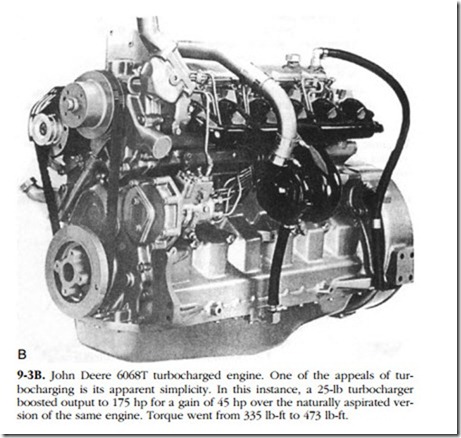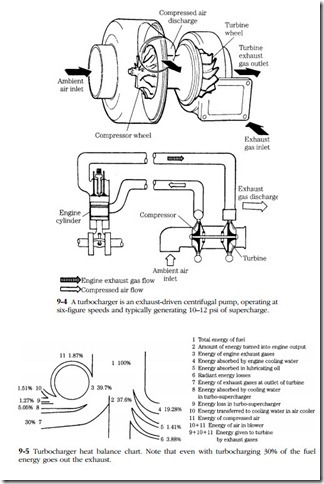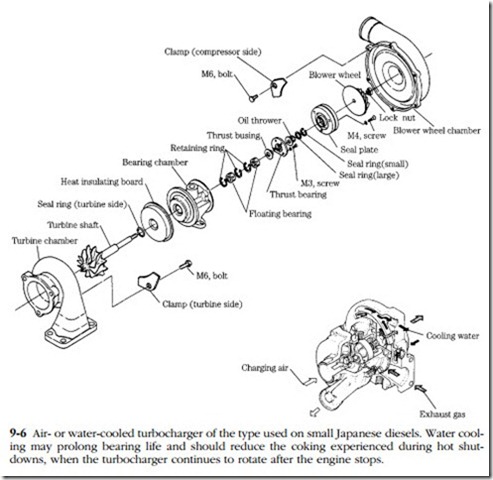Turbochargers
A turbocharger is an exhaust-powered supercharger, that unlike conventional super- chargers, has no mechanical connection to the engine (Figs. 9-3b and 9-4). The exhaust stream, impinging against the turbine (or “hot”) wheel, provides the energy to turn the compressor wheel. For reasons that have to do with the strength of materials, turbo boost is usually limited to 10 or 12 psi. This is enough to increase engine output by 30—40%.
Turbocharging represents the easiest, least expensive way to enhance performance. It is also something of a “green” technology, because the energy for compression would otherwise be wasted as exhaust heat and noise (Fig. 9-5). On the other hand, the interface between sophisticated turbo machinery, turning at speeds as great as 140,000 rpm and at temperatures in excess of 1000°F, and the internal combustion engine is not seamless.
Unless steps are taken to counteract the tendency, turbochargers develop maxi- mum boost at high engine speeds and loads. The turbine wheel draws energy from exhaust gas velocity and heat, qualities that increase with piston speed and load. The
compressor section behaves like other centrifugal pumps, in that pumping efficiency is a function of impeller speed. At low speeds, the clearance between the rim of the impeller and the housing shunts a large fraction of the output. At very high rotational speeds, air takes on the characteristics of a viscous liquid and pumping efficiency approaches 100%. In its primitive form, a turbocharger acts like the apprentice helper, who loafs most of the day and, when things get busy, becomes too enthusiastic.
Another innate, but not necessarily uncorrectable, characteristic of turbocharged engines is the lag, or flat spot, felt during snap acceleration. Perceptible time is required to overcome the inertia of the rotating mass. By the same token, the wheels continue to coast for a few seconds after the engine stops.
Background
The exhaust-driven supercharger was first demonstrated in 1915, but remained impractical until the late 1930s, when the U.S. Army, working closely with General Electric, developed a series of liquid-cooled and turbocharged aircraft engines. The expertise in metallurgy and high temperature bearings gained in this project made GE a leader in turbocharging and contributed to its success with jet engines.
As applied to aircraft, turbocharging was a kind of artificial lung that normalized manifold pressure at high altitudes. A wastegate deflected exhaust gases away from the turbine at low altitudes, where the dense air would send manifold pressures and engine power outputs to dangerously high levels. In emergencies, P-51 pilots were instructed to push their throttles full forward, an action that broke a restraining wire, closed the wastegate, richened the mixture, and initiated alcohol injection for a few seconds of turboboost. The broken wire was a telltale sign, signaling the ground crew to rebuild the engine.
Turbochargers continue to be used on reciprocating aircraft engines and enjoy some currency in high performance automobiles, thanks to electronic controls that minimize detonation. But diesel engines are the real success story.
Turbocharging addresses the fundamental shortcoming of compression ignition, which is the delay between the onset of injection and ignition. That delay, terminated by the sudden explosion of puddled fuel, results in rapid cylinder pressure rise, rough running and incomplete combustion with attendant emissions. Turbocharging (and supercharging generally) increase the density of the air charge. Ignition temperature develops early during the compression stroke and coincides more closely with the onset of injection. Fuel burns almost as quickly as delivered for a smoother running, cleaner, and more economical engine.


